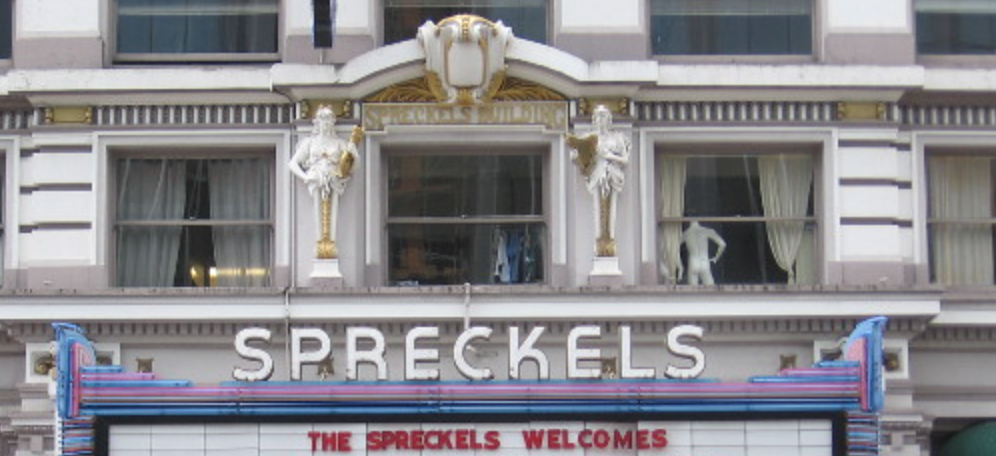Landmarks
The Spreckels Theater
1912
123 Broadway
Architect: Harrison Albright
Architectural Style: Chicago Style Commercial
Interior: Baroque
In 1868, Thomas Whaley leased out the second floor of his house and his adjoining corral to Thomas W. Tanner for $20 in gold. After removing 12 feet of studding and a portion of the east end railing, Tanner erected a stage in the upstairs bedroom, crammed in benches to seat 150 people and presented the first professional shows in San Diego. It must be noted that all this occurred in Old Town.
Most of the ensuing professional entertainment occurred in Alonzo Horton’s New Town or what is now downtown San Diego. The prime talent showcases at the time were Horton Hall (1869), Leech’s Opera House (1884), Louis Opera House (1887) and Fisher Opera House (1892). However, to meet the additional demands for entertainment that the forthcoming Panama-California Exposition of 1915 would bring, new and bigger venues were needed.
Enter John D. Spreckels, heir to Claus Spreckels’ sugar fortune and premier philanthropist, developer and businessman. Although he had been born into a wealthy family, he first worked for his father and then established his own shipping business. This allowed him to become enormously wealthy on his own. He moved to San Diego in 1887, and was immediately impressed with the real estate boom sweeping the area at the time. At various times, he owned all of North Island, the San Diego-Coronado Ferry System, the Union Tribune Publishing Company, the San Diego Electric Railway, the San Diego and Arizona Railway and Belmont Park in Mission Beach. He was, in short, the richest man in San Diego.
Spreckels felt that it was good to be rich and powerful, but that one should also be a “Good Steward” of the community one lived in. After being appointed First Vice President of the organizing committee for the upcoming exposition, he, along with his brother, followed in their father’s footsteps and donated the Spreckels Outdoor Organ Pavilion in Balboa Park to the citizens of San Diego. Claus had given an outdoor Music Temple to Golden Gate Park in San Francisco. John paid the salaries of the resident organist, Dr. Humphrey J. Stewart, and an organ tuner for many years, thus providing for daily organ concerts for San Diegans until September 1, 1929.
John D. Spreckels wanted only the best for his adopted city, and to this end, he hired Harrison Albright as the architect for his next project – a theater to address the projected entertainment needs of San Diego. Albright worked primarily in Los Angeles, but he had already designed several buildings in San Diego including the Union Building, the US Grant Hotel, the Timken Building and the San Diego Hotel. He also went on to design the luxurious Spreckels’ home in Coronado.
The theater, a truly remarkable building, was begun in 1911 and completed in 1912. At the time of its construction, it was the largest reinforced concrete building in California, and one of few truly modern structures in San Diego, both in its use of materials and in the overall design. Previously, the prevalent Victorian architecture emphasized applied decorative details; the new Chicago style depended on vertical structural lines and windows as large panels of glass between structural elements. Albright designed the building to follow the general pattern of the Union Building in height, bulk and general exterior concept. The theater, however, does have some decorative detailing under the projecting cornice line of the roof.
During construction three steel trusses, each 88 feet long, were brought in to be used as reinforcement. Because of the trusses, no supporting columns were necessary in the auditorium to interfere with sightlines of the stage. It also allowed for an enormous stage with unusually huge exits at either end. When “Ben Hur” was performed, a horse-drawn chariot drove across the stage from the 1st St. side and exited onto 2nd Street! Noteworthy, even by modern standards, were the heating, lighting, ventilation and servicing systems.The backstage areas and equipment and the acoustical qualities are considered on par with the much newer Civic Center on B Street.
In contrast with its modern exterior, the richly elegant interior reflects a more European Baroque flavor. The decor features ivory and gold paint with marble, onyx and crystal accents. Murals in the Venetian style adorn the ceiling, with one, above the center of the stage, featuring two angels sprinkling riches from a horn of plenty over San Diego. The venue contains 1,915 seats, a nod to the year of the exposition.
Spreckels hired Jack Dodge and Harry Hayward as theater managers, and gave them one simple task. The annual audit need not show a profit, as nothing was due on the lease. Even a deficit was acceptable, as long as the show quality was first class. To this day, San Diegans have not been disappointed.
The list of performers appearing at the Spreckels is no less impressive than the stellar performance venue. Some well known oldies include Will Rogers, Anna Pavlova, Paul Whiteman, John Barrymore, Enrico Caruso, Mary Pickford, Ronald Coleman, Bela Lugosi, Ronald Reagan, Bert Lahr, Ed Wynn and Abbott and Costello.
In more modern times, when fire destroyed the Old Globe Theatre in Balboa Park, the Spreckels hosted its 1978-79 season. Additionally, the theater regularly hosts Conan O’Brien for a week during Comic Con, so he can interview big name television show stars as part of his talk show.
San Diego’s Spreckels Theater Building was listed on the National Register of Historic Places in 1975 and a San Diego Historical Landmark in 1972. It continues to operate as a theater. There’s always a showstopper listed on their marquee!
Sandee is the Historian/Lead Tour Guide for the Gaslamp Quarter Historical Foundation. She can be reached at [email protected].

